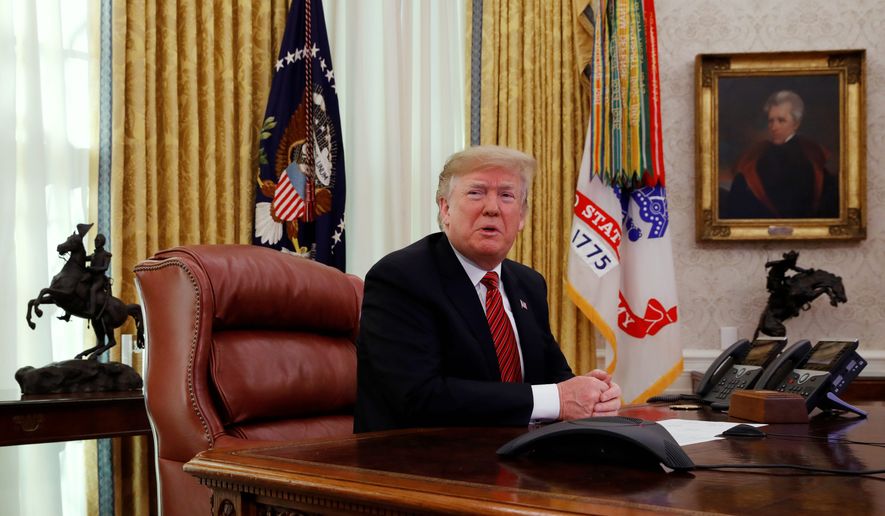President Trump, like his predecessors, has done virtually nothing to stop America’s runaway debt train.
Borrowing, spending and budget deficits have soared during Mr. Trump’s first two years with a Republican-led Congress. The red ink for the current fiscal year is projected to reach nearly $1 trillion, up from a deficit of $833 billion in fiscal 2018.
The smallest federal budget deficit in the past decade was $458 billion, in 2015. Even that relatively good year came on the heels of four consecutive trillion-dollar-plus deficits under President Barack Obama.
The overall national debt is a near-record 78 percent of gross domestic product, and it is forecast to equal the nation’s total economic output in 13 years. Four years from now, taxpayers will be paying more on interest payments on the federal debt than they pay for defense.
Budget analysts who have been warning for years about the country’s worsening fiscal predicament are almost out of words.
“I don’t know what to say,” former Congressional Budget Office director Douglas Holtz-Eakin told a House committee this month. “The outlook is dire, and it will have consequences.”
In October, the president ordered his department heads at a Cabinet meeting to cut 5 percent from each of their agency’s budgets. He asked them to report back to him at their next meeting.
“Rather than go by the penny plan, we’ll call it the nickel plan,” Mr. Trump told them. “At least it will be a one-year nickel plan. It’s tremendous amounts of money, and it’s something that we can do. I believe we could actually do it easily.”
That was more than two months ago. The White House did not respond to inquiries on whether any progress has been made.
The president came into office vowing to slay the deficit dragon. But he said his first order of business was to rebuild the military, which had been depleted during budget caps under Mr. Obama.
To get record funding for the Pentagon, Democrats made Mr. Trump swallow extra spending for social programs in a mammoth $1.3 trillion budget deal in 2017. The president has vowed it will never happen again.
But the spending outlook is even dicier now that Democrats are gaining the House majority this week. They are expected to push more funding for education, health care and other non-defense spending.
Democrats say the government’s deficit forecasts have been worsened by the Republican tax cuts of 2017, which received not a single Democratic vote.
“The Republican tax scam pushed through by the congressional Republicans and Donald Trump during this Congress explodes deficits by an estimated $2.3 trillion from 2018 through 2028, leaving future generations to foot the bill,” said Rep. Maxine Waters, California Democrat and incoming chairwoman of the House Financial Services Committee.
The committee’s retiring chairman, Republican Rep. Jeb Hensarling of Texas, noted that the Treasury Department reported in October that federal revenue has risen slightly — 0.4 percent — over the previous fiscal year.
White House economic council Chairman Kevin Hassett said deficits have been affected partly by “front-loaded” aspects of the tax law that allow companies to deduct large amounts for capital expenses early in the process. He said the tax cuts will spur more revenue in later years.
“If you get the growth that we see this year, and if that continues, then the revenue feedback effects become enormous as you go out to the end of the period,” he told reporters.
Mr. Hensarling convened a hearing in late December on the perils of unsustainable government debt. He said he could have held such a session in any given year during his 16-year House tenure.
“Only the numbers change, and they change for the worse,” he said.
Fiscal analysts say Congress’ inability to balance the federal budget is worrisome, but the much bigger driver of deficits is the unchecked growth of mandatory entitlement spending.
“They are at the heart of the budget problem,” Mr. Holtz-Eakin said. “They are outstripping our capacity to finance them.”
Social Security, Medicare, Medicaid and Obamacare account for about two-thirds of federal spending each year. The shortfalls in Social Security and Medicare, plus interest payments on the debt from those two programs, make up 90 percent of the projected deficit increases over the next decade.
“The fastest-growing parts of the budget are Social Security, health programs like Medicare and Medicaid, and interest payments on the debt — each of which does not go through the annual appropriations process and is growing faster than the economy,” Maya MacGuineas, president of the Committee for a Responsible Federal Budget, told lawmakers. “Mandatory spending and interest have already grown from 61 percent of the budget in 2010 to 69 percent today, and they are projected to be at 77 percent in 2028.”
That leaves less room for the government to pay for other priorities and gives lawmakers less ability to respond to emergencies, such as a deep recession, wars or natural disasters.
She also noted that China is the largest foreign owner of U.S. debt, with $1.1 trillion.
“Trade and other tensions with them can certainly affect their lending decisions,” she said. “Moreover, given our unstable political relationship with China, it is less than ideal to be as dependent on them as we are for funds.”
• Dave Boyer can be reached at dboyer@washingtontimes.com.




Please read our comment policy before commenting.